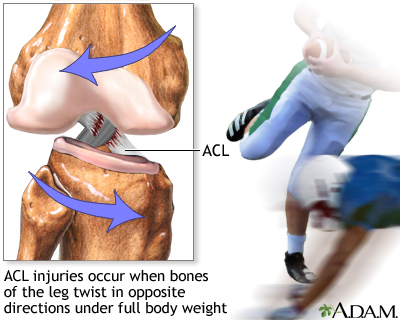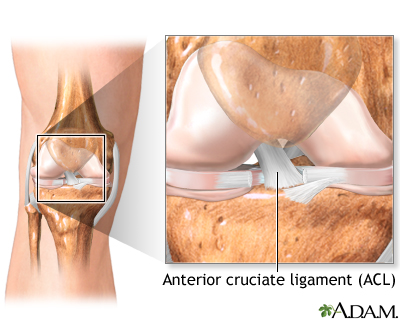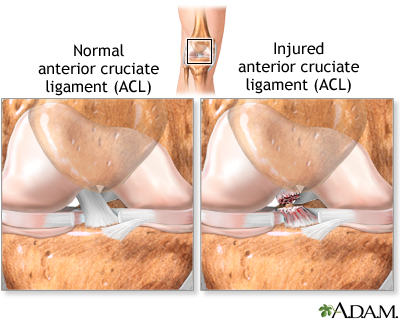Anterior cruciate ligament (ACL) injury
Cruciate ligament injury - anterior; ACL tear; Knee injury - anterior cruciate ligament (ACL)
An anterior cruciate ligament injury is the over-stretching or tearing of the anterior cruciate ligament (ACL) in the knee. A tear may be partial or complete.
Images





Presentation

I Would Like to Learn About:
Considerations
The knee joint is located where the end of the thigh bone (femur) meets the top of the shin bone (tibia).
Four main ligaments connect these two bones:
- Medial collateral ligament (MCL) runs along the inside of the knee. It prevents the knee from bending inward.
- Lateral collateral ligament (LCL) runs along the outside of the knee. It prevents the knee from bending outward.
- Anterior cruciate ligament (ACL) is in the middle of the knee. It prevents the shin bone from sliding out in front of the thigh bone.
- Posterior cruciate ligament (PCL) works with the ACL. It prevents the shin bone from sliding backward under the femur.
Women are more likely to have an ACL tear than men.
Causes
An ACL injury can occur if you:
- Get hit very hard on the side of your knee, such as during a football tackle
- Overextending your knee joint
- Quickly stop moving and change direction while running, landing from a jump, or turning
Basketball, football, soccer, and skiing are common sports linked to ACL tears.
ACL injuries often occur with other injuries. For example, an ACL tear often occurs along with tears to the MCL and the shock-absorbing cartilage in the knee (meniscus).
Most ACL tears occur in the middle of the ligament, or the ligament is pulled off the thigh bone. These injuries form a gap between the torn edges, and do not heal on their own.
Symptoms
Early symptoms:
- A "popping" sound at the time of injury
- Obvious knee swelling within 6 hours of injury
- Pain, especially when you try to put weight on the injured leg
- Difficulty in continuing with your sport
- Feeling of instability
Those who have only a mild injury may notice that the knee feels unstable or seems to "give way" when using it.
First Aid
See your health care provider if you think you have an ACL injury. Do not play sports or other activities until you have seen a provider and have been treated.
Your provider may send you for an MRI of the knee. This can confirm the diagnosis. It may also show other knee injuries.
First aid for an ACL injury may include:
- Raising your leg above the level of the heart
- Putting ice on the knee
- Pain relievers, such as nonsteroidal anti-inflammatory drugs (such as ibuprofen)
You also may need:
- Crutches to walk until the swelling and pain get better
- Brace to give your knee some stability
- Physical therapy to help improve joint motion and leg strength
- Surgery to reconstruct the ACL
Some people can live and function normally with a torn ACL. However, most people complain that their knee is unstable and may "give out" with physical activity. Unstable knee after ACL tears can lead to further knee damage. You are also less likely to return to the same level of sports without the ACL.
Do Not
- Do NOT move your knee if you have had a serious injury.
- Use a splint to keep the knee straight until you see a doctor.
- Do NOT return to play or other activities until you have been treated.
When to Contact a Medical Professional
Contact your provider right away if you have a serious knee injury.
Get immediate medical attention if the foot is cool and blue after a knee injury. This means that the knee joint may be dislocated, and blood vessels to the foot may be injured. This is a medical emergency.
Prevention
Use proper techniques when playing sports or exercising. Some college sports programs teach athletes how to reduce stress placed on the ACL. This involves a series of warm up exercises and jumping drills. There are jumping and landing exercises that have been shown to reduce ACL injuries.
The use of knee braces during vigorous athletic activity (such as football) is controversial. It has not been shown to reduce the number of knee injuries, but not specifically ACL injuries.
Related Information
Knee arthroscopyACL reconstruction
ACL reconstruction - discharge
References
Bolgla LA. Gender issues in ACL injury. In: Giangarra CE, Manske RC, eds. Clinical Orthopaedic Rehabilitation: A Team Approach. 4th ed. Philadelphia, PA: Elsevier; 2018:chap 49.
Brotzman SB. Anterior cruciate ligament injuries. In: Giangarra CE, Manske RC, eds. Clinical Orthopaedic Rehabilitation: A Team Approach. 4th ed. Philadelphia, PA: Elsevier; 2018:chap 47.
Cheung EC, McAllister DR, Petrigliano FA. Anterior cruciate ligament injuries. In: Miller MD, Thompson SR, eds. DeLee, Drez, & Miller's Orthopaedic Sports Medicine. 5th ed. Philadelphia, PA: Elsevier; 2020:chap 98.
Kalawadia JV, Guenther D, Irarrazaval S, Fu FH. Anatomy and biomechanics of the anterior cruciate ligament. In: Prodomos CC. The Anterior Cruciate Ligament: Reconstruction and Basic Science. 2nd ed. Philadelphia, PA: Elsevier; 2018:chap 1.
Miller RH, Azar FM. Knee injuries. In: Azar FM, Beaty JH, eds. Campbell's Operative Orthopaedics. 14th ed. Philadelphia, PA: Elsevier; 2021:chap 45.
Nyland J, Mattocks A, Kibbe S, Kalloub A, Greene JW, Caborn DN. Anterior cruciate ligament reconstruction, rehabilitation, and return to play: 2015 update. Open Access J Sports Med. 2016;7:21-32. PMID: 26955296 pubmed.ncbi.nlm.nih.gov/26955296/.
BACK TO TOPReview Date: 6/8/2022
Reviewed By: C. Benjamin Ma, MD, Professor, Chief, Sports Medicine and Shoulder Service, UCSF Department of Orthopaedic Surgery, San Francisco, CA. Also reviewed by David C. Dugdale, MD, Medical Director, Brenda Conaway, Editorial Director, and the A.D.A.M. Editorial team.

Health Content Provider
06/01/2025
|
A.D.A.M., Inc. is accredited by URAC, for Health Content Provider (www.urac.org). URAC's accreditation program is an independent audit to verify that A.D.A.M. follows rigorous standards of quality and accountability. A.D.A.M. is among the first to achieve this important distinction for online health information and services. Learn more about A.D.A.M.'s editorial policy, editorial process and privacy policy. A.D.A.M. is also a founding member of Hi-Ethics. This site complied with the HONcode standard for trustworthy health information from 1995 to 2022, after which HON (Health On the Net, a not-for-profit organization that promoted transparent and reliable health information online) was discontinued. |
The information provided herein should not be used during any medical emergency or for the diagnosis or treatment of any medical condition. A licensed medical professional should be consulted for diagnosis and treatment of any and all medical conditions. Links to other sites are provided for information only -- they do not constitute endorsements of those other sites. © 1997- 2024 A.D.A.M., a business unit of Ebix, Inc. Any duplication or distribution of the information contained herein is strictly prohibited.
